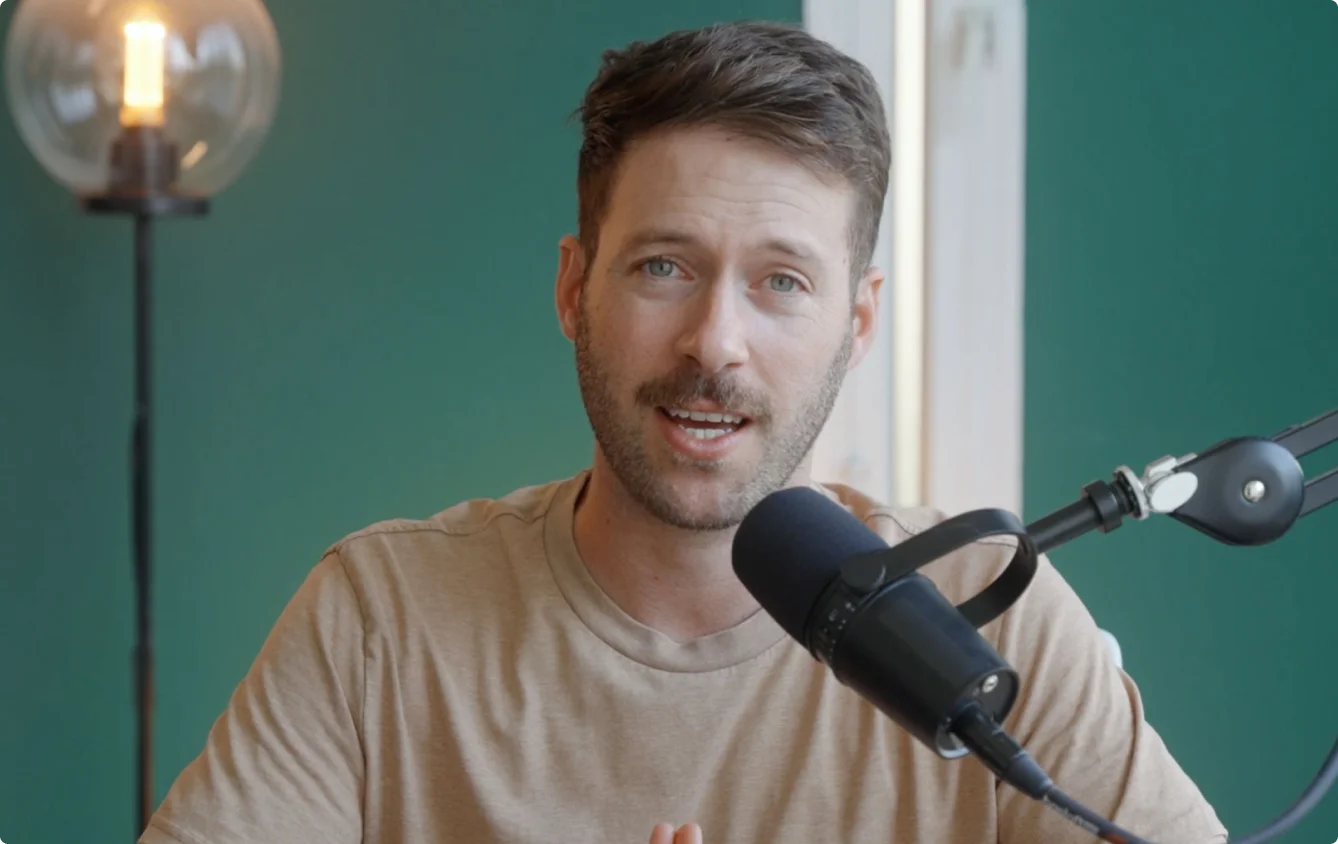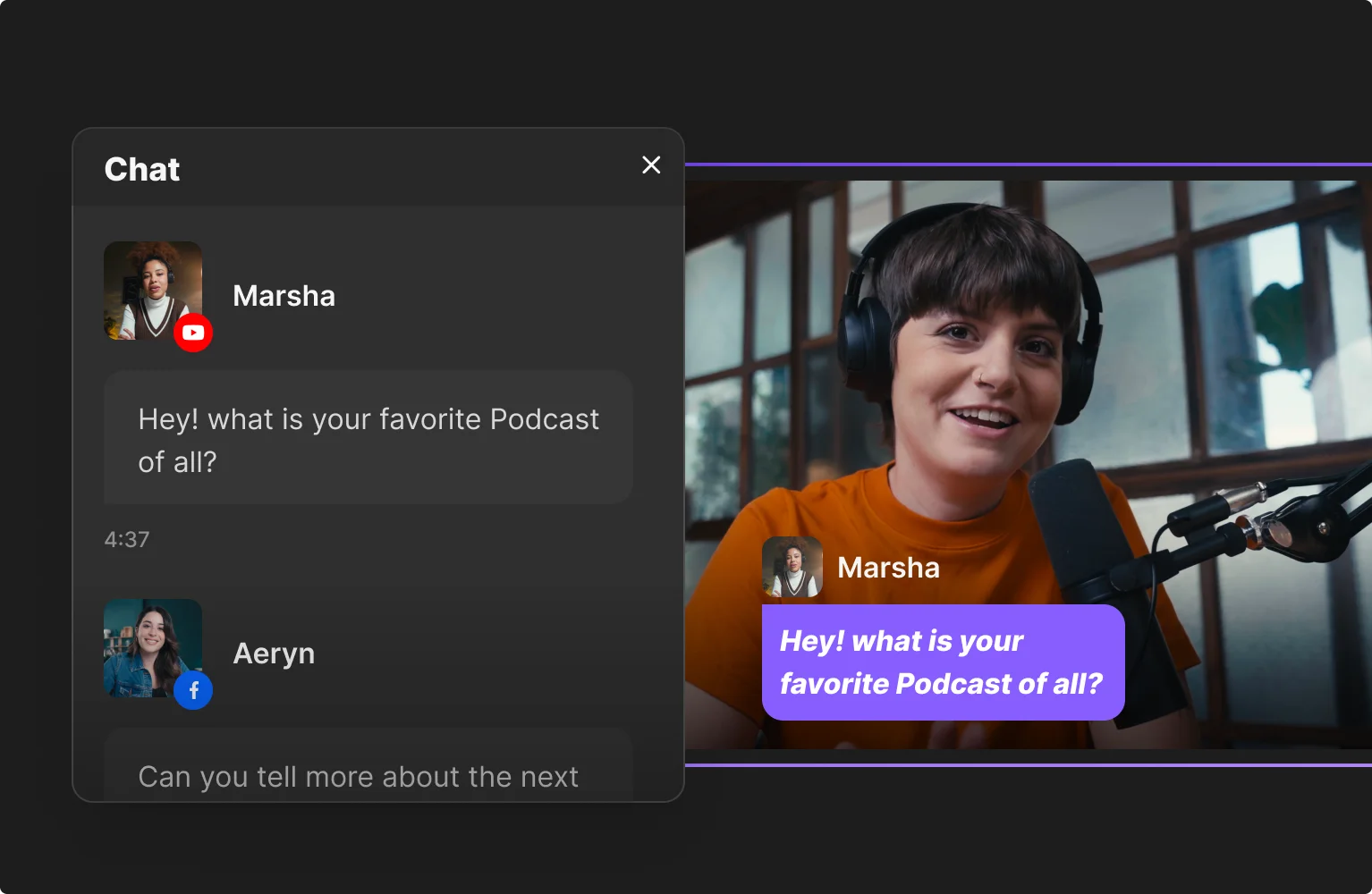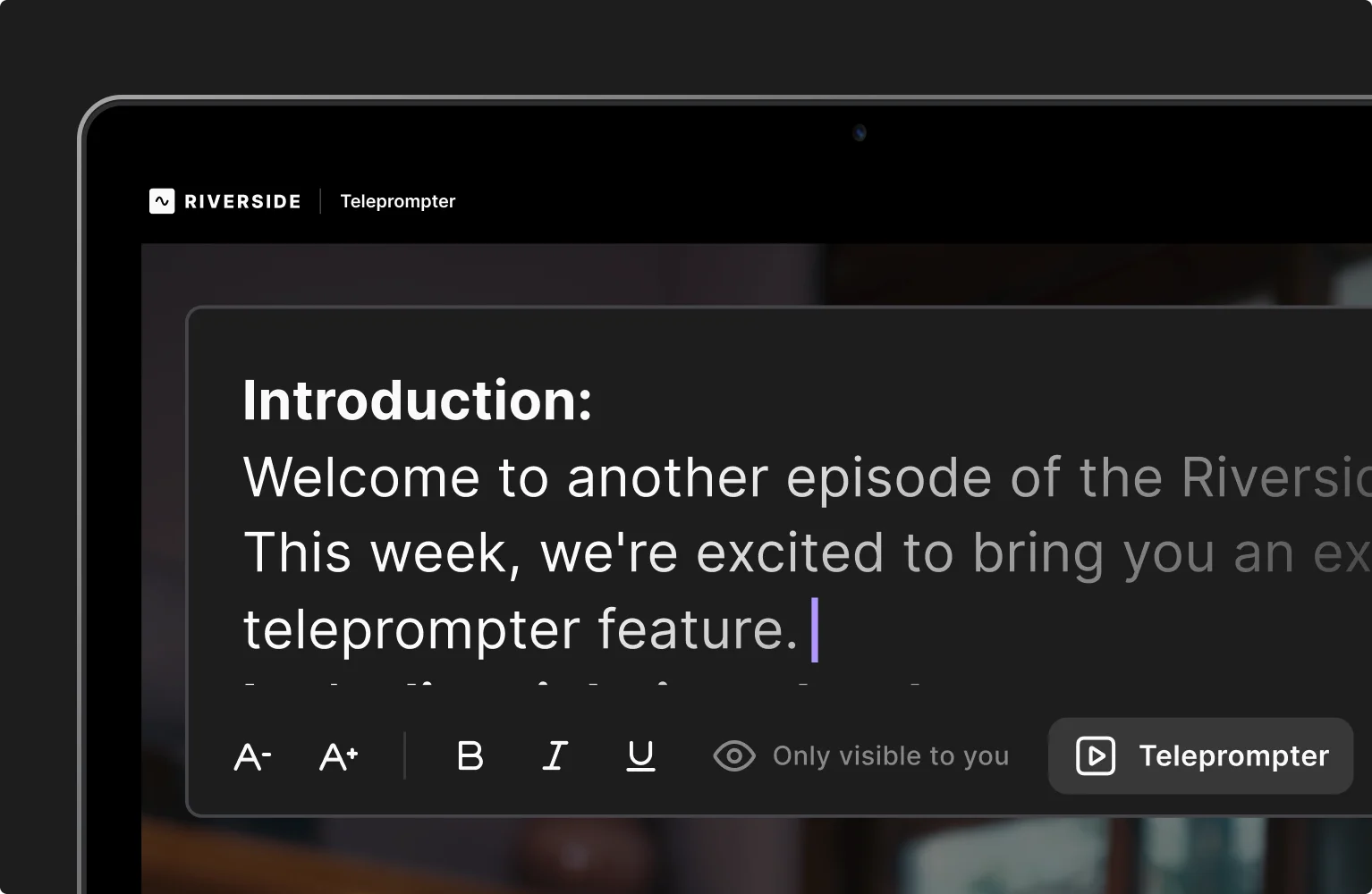Table of contents:
What is podcast structure?
Podcast structure by format + examples
How to structure a podcast episode step by step (+ a free template)
General podcast episode template
Why podcast structure matters
FAQs about podcast structure
Key takeaways:
- Structure is the backbone of a good podcast. The simplest structure—intro, core, outro—gives your show rhythm and makes it easier for listeners to follow.
- Podcast format shapes structure. Interviews, solo episodes, panels, and storytelling podcasts each rely on different structures to stay engaging.
- Structure builds trust and retention. Most podcasts lose listeners in the first few minutes. A strong, consistent arc helps people stay longer, return for future episodes, and even makes editing and monetization easier.
Every great podcast has one thing in common: it feels seamless, with each moment leading naturally to the next.
Podcast structure makes that possible. When you plan episodes intentionally, you'll record more confidently and create an experience that keeps your listeners engaged from beginning to end.
Here we’ll take a look at podcast structure and show you how to choose and apply a structure to your own podcast.
Let’s do this!
What is a podcast structure?
A podcast structure is the blueprint for your episode. At the simplest level, every podcast has three main parts: an intro, a body, and a conclusion. How you fill those parts is what gives your show its flow and personality.
Here are some of the key components of a podcast structure:
- Intro or hook: The first few seconds of any show are critical. This is where you grab attention and set expectations so people keep listening.
- Welcome: A quick greeting, often with your name, the show’s name, and what the episode is about.
- Main content: The heart of the episode. This could be an interview, a solo monologue, a panel discussion, or a story you’re telling.
- Call-to-action (CTA): A short prompt that nudges listeners to subscribe, share, leave a review, or check out something you’ve mentioned.
- Outro: The close of your episode, usually a thank-you and any final notes or teasers for what’s next.
This structure gives your podcast a natural rhythm, but it’s just the starting point. The way you arrange and adapt these pieces depends on your podcast format.
Podcast structure by format + examples

Your podcast format plays a big role in shaping the structure of your episodes. While the intro–body–conclusion framework is universal, each format leans on different elements to create the right rhythm and listener experience.
Let's break down the most common podcast formats.
Interview podcasts
The structure of an interview podcast is simple on paper: introduce your guest, ask questions, and wrap things up. But what makes interviews engaging is how you guide the conversation. A good structure includes a clear intro that explains who the guest is and why they matter, a set of prepared questions to shape the discussion, and space to let the guest’s stories unfold naturally.
A classic example is The Tim Ferriss Show. Ferriss always sets up who his guest is and why listeners should care before moving into long-form conversations. His interviews are structured enough to cover key themes, but flexible enough to let interesting tangents play out (think: a story about a failure or a personal habit). This balance is what makes the format engaging, and why it works so well.
Solo podcasts
With solo shows, you (the host) carry the entire episode, so structure becomes even more important. Most episodes open with a strong hook (a bold statement or personal story) before moving into clearly defined sections or talking points. Finally, the outro ties it all together with a call to action. Basically, you want to break your episode into chunks, like mini-chapters, that make it easier for your audience to follow along.
For example, take The GaryVee Audio Experience, where Vaynerchuk uses solo episodes to share sharp, focused insights. He relies on structure to avoid rambling, with an intro that sets expectations, a tight core segment, and a direct message to listeners to close out the show.
Read more: If you’re considering a solo podcast, our guide to solo podcasts has more strategies to keep episodes engaging.
Co-hosted podcasts
When two (or more) hosts share the mic, the podcast structure is often conversational. Episodes usually begin with light banter that establishes chemistry before transitioning into the main topic. The discussion itself can be broken into themes, recurring segments, or a free-flowing debate.
Pod Save America is a great example. The hosts balance casual back-and-forth with structured discussions of political events. The consistency of their format—banter, deep dive, wrap-up—gives listeners a reliable experience, while the chemistry between hosts keeps it engaging.
Panel podcasts
Panel shows bring multiple voices together, often with a moderator to guide the conversation. Without structure, they can quickly become overwhelming. Successful panel podcasts introduce each participant, outline the topics, and direct questions so everyone gets airtime. The moderator’s role is to keep things moving and ensure everyone has space to contribute.
For instance, The Moth Radio Hour brings in multiple storytellers, but the host’s framing gives context and ties each story into the bigger theme. If you’re running a panel, think of yourself as the traffic controller. Your job is to guide the conversation, prevent interruptions, and make sure no voice gets lost.
Narrative or storytelling podcasts
Storytelling formats borrow from journalism and film. They open with a scene-setter or dramatic hook, then move through the story in a clear arc (chronological or thematic). These shows often combine narration, interviews, and sound design to keep listeners immersed. Episodes end with a resolution, a cliffhanger, or a closing reflection.
The Serial podcast set the standard here. Its episodes are carefully structured, with narration guiding listeners through layers of a complex story. Each episode builds suspense while still providing enough resolution to feel complete, making it addictive to binge.
Educational or how-to podcasts
Educational podcasts are built on clarity. They start with a question or problem statement, then break the episode into distinct lessons or steps. The outro reinforces what was covered and points listeners to additional resources. Segmenting the episode makes it easier for listeners to absorb information and apply it.
Stuff You Should Know has mastered this approach. The hosts take complex topics and structure them into digestible, conversational segments. Their episodes feel approachable but always follow a clear arc: setup, exploration, and wrap-up. Previous episodes have explained how the electoral college works and how juggling works, for example.
Read more: For help structuring educational episodes, try our podcast script templates.
Branded or business podcasts
Branded podcasts often mirror traditional formats but with a polish that reflects the company’s identity. Episodes usually open with a professional, branded intro, then unfold into stories or expert interviews, and close with a CTA aligned to business goals.
Inside Trader Joe’s is a great example. It weaves staff interviews and behind-the-scenes stories into a narrative that reflects the company’s culture. The episodes always feel intentional and aligned with the brand, without sliding into “ad” territory.

Bonus: Structure wildcards
Of course, some podcasts throw the rulebook out the window. Some shows experiment with structure to stand out. Here are a few examples:
- Segment-based podcasts break episodes into recurring sections, like “listener mail,” “hot takes,” or “rapid-fire tips.” This gives variety while keeping a familiar rhythm.
- Cold-open podcasts skip the intro entirely and dive straight into the action. This format is perfect for short-form content or audiences who want zero fluff.
- Series arcs spread one story across multiple episodes, turning the season itself into the “structure.” This format works well for investigative or documentary-style podcasts.
- Hybrid formats combine elements, like a solo monologue followed by an interview. This allows you to mix consistency with freshness.
Wildcards work when they still give the audience something to latch onto, whether that’s recurring segments, predictable pacing, or a strong host voice.
Want to pick the format that’s right for you? Our guide on how to start a podcast covers choosing the best approach for your goals.
How to structure a podcast episode step by step (+ a free template)
Once you’ve chosen your format, the real work begins: shaping each episode to engage listeners until the very end. Here’s how to take an idea from outline to recording:
Step 1: Break your episode into blocks that serve a purpose
You'll start by building a skeleton for your episode. Instead of thinking vague terms like “intro, middle, outro,” get specific about the functional blocks of your show.
- The hook: What buys you the first 60 seconds of attention? This could be a bold claim, a surprising stat, or a powerful clip from your guest.
- The setup: A quick welcome and what listeners can expect today.
- Core chapters: The meat of the episode, broken into themes or questions, each one with a natural end point before you move on.
- Reset moments: This can be 10-second pauses, summaries, or transitions that give the listener a breath and keep them from tuning out.
- The close: A recap that reminds listeners what they got and one clear call to action.
You don't have to use every block. Choose the ones that keep your episode moving forward.
And remember that a great structure feels invisible. Listeners aren’t thinking “oh, this is the recap section.” They’re just pulled through the episode without friction.
Step 2: Match your length to your content
Most podcasts are more than 30 minutes, on average. But instead of asking “How long should my podcast be?,” ask “What’s the minimum time this idea needs to feel finished?”

Here are some general guidelines to help you decide how long your podcast should be:
- Short form (10–15 minutes): Works well for sharp tips or single-topic commentary. But you’ll need a tight structure—hook, one or two strong points, recap, done.
- Mid-length (20–40 minutes): The sweet spot for most interviews and how-tos. Long enough for depth, short enough to finish in one sitting.
- Long form (60+ minutes): Needs intentional pacing—segments, chapter breaks, even musical beds—so it doesn’t feel like a slog. If you’re going this long, make sure your structure gives listeners room to reset.
Step 3: Script the scaffolding, not the sentences
Reading a full script makes you sound stiff, but going in empty-handed can leave you rambling. The middle ground is to script the pieces that matter most and keep the rest loose.
Begin with your opener. A strong first line helps you settle in and avoids awkward starts.
Sketch out your transitions. Moving between ideas or wrapping up a segment is where podcasts often feel clunky. A few short bridge lines are enough to keep the flow intact.
Write your call-to-action word-for-word. This part should be clear and confident, not improvised.
For everything else? Bullet points. Prompts and keywords are enough to guide your delivery while leaving room for you to create a natural and genuine conversation.
Pro Tip: Use Riverside’s teleprompter to keep your notes right in front of you.
Step 4: Rehearse before recording
Most pacing issues show up too late, after you’ve already recorded. A quick dry run helps you catch them early.
Read your outline aloud with a timer running. Pay attention to:
- The hook: Do you get to the point in under a minute?
- Segment length: Does each block stay in its lane, or does one overwhelm the episode?
- The close: Do you end cleanly, or trail off?
Even a 10-minute test can save you hours in editing. If it drags in rehearsal, it'll drag even more in the final recording.
Step 5: Record in blocks, not in one take
Break your episode into pieces (intro, segments, outro) and record each one separately.
This makes mistakes easier to handle, since you only need to redo a single section. It also keeps your energy up, and gives you flexibility in editing. You can move, trim, or swap blocks without breaking the whole episode.
This is where Riverside shines: you can record each block separately, capture everyone’s audio and video locally in high quality, and drop markers at transitions so you know exactly where to cut. That way, you’re not fixing problems in post—you’re assembling clean, intentional pieces.
Expert guide: Are you planning your podcast episodes correctly? Check this planning guide from PRISM Agency to know if you are!
General podcast episode template
Use this template to outline and structure a single episode before you record.
Download the template
Episode Details
- Episode title: (.........)
- Format (interview, solo, co-hosted, etc.): (.........)
- Target length: (.........)
- Publishing date: (.........)
Hook/Cold open (0:00–0:45)
What clip, line, or fact grabs attention right away?
Music / Branded intro (0:45–1:00)
Your theme music, brand voiceover, or any recurring intro “bumper” that identifies your show.
Welcome & setup (1:00–3:00)
Host intro, guest intro (if any), and promise of value for the listener.
Core segment 1 (3:00–12:00)
- Theme/Question: (.........)
- Key points to cover:
- Examples/stories to include: (.........)
Core segment 2 (12:00–20:00)
- Theme/Question: (.........)
- Key points to cover:
- Examples/stories to include: (.........)
Reset/Transition (20:00–21:00)
Quick summary or handoff into next section.
→ (.........)
Core segment 3 (21:00–30:00)
- Theme/Question: (.........)
- Key points to cover:
- Examples/stories to include: (.........)
Recap (30:00–32:00)
2–3 takeaways you want the listener to leave with.
→ (.........)
Call to action (32:00–33:00)
What’s the one thing you want listeners to do? (subscribe, share, review, etc.)
→ (.........)
Outro (33:00–34:00)
Closing thank you + teaser for next episode.
→ (.........)
Why podcast structure matters

Most podcasters underestimate how fragile listener attention really is. In one recent analysis, hosts reported losing 15–20% of listeners by the two-minute mark. Other benchmarks suggest that a “healthy” retention curve means holding 70% of listeners through the first quarter of your show and 50% through to the end.
The problem is rarely content quality. More often, it’s pacing. Without structure, an episode meanders: too much small talk at the open, too many tangents in the middle, or an ending that drifts instead of landing. Listeners sense the lack of direction immediately. If the show feels aimless, they'll move on.
Good structure solves this on two fronts:
- For the listener, it creates rhythm: a clear hook at the start, enough “reset” moments in the middle to keep attention fresh, and a clean resolution at the end.
- For the host, it reduces friction. You know where to start, when to pivot, and how to land, which makes you sound more assured. It also makes podcast editing faster and easier!
Podcast structure is also a business decision. Episodes with clean, predictable arcs are easier to break down into chapters, easier to repurpose into clips, and easier to monetize. This is because advertisers pay premiums for shows that can prove consistent retention.
Most importantly, structure is how you build trust. Listeners return when they know what to expect. Not sameness, but consistency - an episode that starts with purpose, follows through, and closes intentionally. Over time, that predictability becomes part of your brand, turning one-time listeners into long-term subscribers.
Tip: Keep in mind that even the best podcast structure won’t win over your audience if your audio quality is poor and your footage is badly stitched together. Use Riverside's recording software combined with a high-quality microphone to be sure your show’s sound is just as professional as its structure.
FAQs about podcast structure
What is a segment in a podcast?
A segment is a defined section of your episode. It could be the intro, a guest interview, a Q&A, or even a recurring feature like “listener questions.” Segments give your episode natural breaks and keep the flow easy to follow.
How many segments should a podcast have?
Most podcasts have 3 main segments: the intro, the core content, and the outro. You can add more (like a lightning round or listener questions), but 3–4 segments is usually enough to keep the episode focused without dragging.
What is the most popular podcast format?
Interview podcasts are the most popular. They make it easy to bring in fresh voices and keep content varied, which is why so many shows use this format.



















.webp)
.webp)






